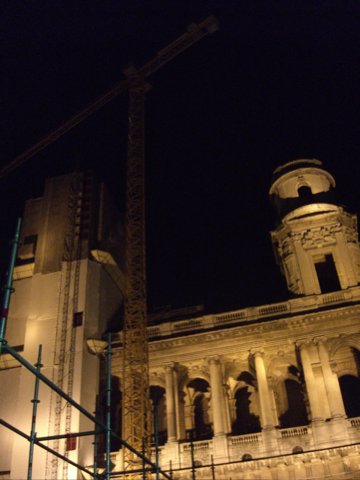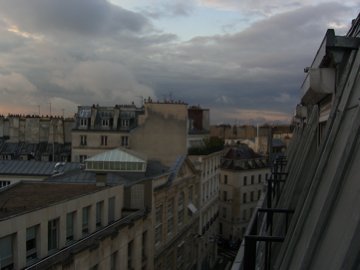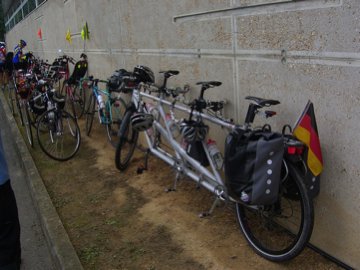From Velonews: A cycling nutrition article that focuses on taking in the right stuff to keep your brain functioning at optimum levels. Link: The Feedzone with Monique Ryan: Feed your head.
I Have Never …
Like U.S. Senator Larry Craig, R-Idaho, I want to assure my constituents that I have never Bengay.
Footprint
Flying back from Paris on Saturday, our Air France 747 crossed southern Greenland. It’s one of the places I’d love to visit — to see the site of the medieval Norse settlements, if nothing else. The sight of the place makes a strong impression: A good 15 minutes, or more than 125 miles, before we got to the southeastern coast, individual icebergs appeared in the blue North Atlantic below. Then more and more appeared, as did their source: the glaciers snaking down from the island’s highland ice sheets to the bays on the Atlantic. We saw the glaciers calving dozens, hundreds, thousands of icebergs; icebergs that in some cases were the size of big Midwestern farms. The temptation in the time of “An Inconvenient Truth” is to see the masses of ice floating south as evidence of What We’re Doing to the Planet. The facts are much more complex: The glaciers have always calved icebergs in volumes that would amaze the first-time beholder; there’s likely a difference now from 1912, say, when one particularly famous iceberg trundled out to sea, but it’s not visible from a single pass in an airliner. Still, we can be reasonably certain that though the differences in the ice’s behavior might be subtle on a discreet level — this is what I saw on one day — they likely represent something profound about planetary climate.
Prompted partly by curiosity and partly by one person’s stark and dire summary of what’s happening around us today and our responsibility for it, I decided to calculate the carbon footprint of our August trip. I’m trying to account just for the big stuff — 4,000 miles of driving in an SUV that averaged 22 or 23 miles per gallon and three long plane trips. I’m not counting any of the electricity we consumed along the way or the cost of transporting the Pringles we bought from the Pringles works to the Rockies.
A calculator available on a site affiliated with “An Inconvenient Truth” suggests that the national average of carbon dioxide emissions per person in the United States is 7.5 tons (another site, CarbonCounter.org, comes up with a significantly higher number, 21.2 tons; other estimates, when they’re stated in a straightforward way, fall between these numbers ). Based on running our numbers for the trip, I come up with an estimate of 3.65 (from the “AIT” site) to 6.65 tons just for the 25 days of our travels. One surprise, to me, is the high figure for air travel, which the various calculators estimate at 2 to 11 tons of carbon dioxide for the flights we took (two long trips — five and six hours — and one extended one, 11 hours).
A lot of these calculators invite you to enter into a contract of some kind, ranging from “I’ll stop throwing away aluminum cans” to making cash payments, to lessen or offset your carbon impact. I even found a site, JunkScience.com, that has an alternative calculator that shows what a pitifully small impact your offset payment will make (the site’s subtext: global warming just ain’t that big a deal, you saps).
Bottom line, whether I can do anything to lessen the impact or not: We spewed out more than our share of CO2 during our little jaunt.
Technorati Tags: global warming, climate change
Le Grand Schlep
OK, I won’t ever do this again, but:
Got up at 5 a.m. to get ready to go to the airport for a 10:15 a.m. flight. The easiest way to get there would have been a 60 euro cab ride — that’s about 80 bucks — but the nice clerk at the hotel found yesterday that no cab company had a car big enough to take my bike box. So that necessitated hauling my unforgivably heavy suitcase, with rollers, and my inconveniently piece-o’-pie-shaped bike box (visual aids will be provided) the quarter-mile or so to the nearest regional train (RER) stop, across the street from the Luxembourg Gardens.
I’ve found Paris in August to be a city that’s late to bed and late to rise, so I knew I could probably haul my luggage right up the middle of my hotel’s little street; after that, the wide sidewalks on the Rue de Virgiraud would suffice. I knew I could pull the two pieces at the same time because I did it when I arrived here 10 days ago; then, however, I had a nice convenient bus ride from the airport, and my bike box rode in a truck with those of all the other PBP types.
I went downstairs from my seventh floor room in the hotel’s tiny elevator, just big enough for me and my suitcase. I paid my bill, pulled my suitcase out to a likely place on the curb, then wrestled my extra-large piece o’ pie out to the street. I lined everything up and started pulling. At the top of the street, the Rue Casimir Delavigne, is the beautifully restored Theatre Odeon. A stationwagon taxi drove a slow circle around the Place de Odeon, and I hoped the driver would see an easy fare and stop. But he didn’t. I continued up to the deserted main street, leaving the bike box behind when I encountered an obstacle, then leaving the suitcase and retrieving the bike. That’s how I got down the multiple flights of stairs into the Luxembourg RER station, where I bought a ticket to Aeroport Charles de Gaulle.
The fare gate was equipped with a door to admit passenger with luggage, but it was locked. I stood contemplating what it would take to lift everything over the gates when a door opened next to the ticket agent’s office and a tall, neatly dressed and vaguely Yves Montand-ish personage appeared. He was going to open the gate so I could take my suitcase through. Then he saw the bike box.
“What is it?” he said, in English.
“My bike.”
“No.
“But. …”
“No. It can’t go. It’s too big.”
“But I brought it on the train from St. Quentin yesterday” — an irrelevant fact even though the St. Quentin train was also on the RER.
“No. It is forbidden.” I had the feeling that was one of Yves’s most used phrases in English.
I had no choice but to plead. I mentioned the fact my flight was leaving today, that I had to get home. I said “please” several times, and the desperation in my tone was not an act. In the back of my mind I was thinking that I’d already been told that a taxi wouldn’t carry the box and that a van shuttle was out of the question because the box was too big for that, too. How would I ever get this thing to the airport if this guy didn’t relent?
Yves didn’t face me directly as I tried to cajole him. He looked at the dark ticket window. I heard him say, “It’s not fair.” Then I saw that Yves was looking at a younger guy in the ticket office; he said something to his younger colleague, who shrugged his shoulders. Finally, he said, “OK. But if you have a problem. …” “Yes — it’s my problem,” I said. Yves opened the gate, and I hustled my stuff down the stairs to the platform. The rest of the trip to the airport was without incident. (If you happen to travel to Paris, the RER trip into the center of the city costs 8.20 euros and is well worth it; just don’t make the trip with an oversize piece o’ pie bike box).
But then there was the airport. As I expected, I had to do the same routine there that I had at the train station: carry one thing up an escalator or stairs, then go back for the other. Several times I had to leave my suitcase unattended. During one of my back-and-forth trips, when I’d left the suitcase at an elevator, I noticed three soldiers, two men and a woman, wearing combat fatigues and carrying automatic rifles. I rode up the escalator behind the woman, who stood facing backward down the escalator with her rifle carried at the ready. It was a little unnerving. The three soldiers got off ahead of me and very casually began walking in the same direction as my suitcase, about 30 meters away. Very casually, they stopped to take a look at it. Unattended luggage. A bag big enough to take out a good piece of the terminal if it were packed by unfriendly travelers. Oh, crap.
“It’s mine,” I said. They turned and looked at me. I wasn’t even trying to communicate in French at this point, and I think that and my hapless appearance suggested that I was on the level as far as the bag was concerned. They motioned I could take the suitcase and go, and I treated them to a demonstration of my dual bag-hauling trick. At the end of the hallway, I reached a point where I had to go up a short escalator to the departure hall. Once more up with the suitcase, leaving the bike box behind. When I returned less than a minute later, three new soldiers were gathering around the bike box. I came back down the escalator, and one of the three said “what is it?” “Mon velo,” I said, a piece of French I was ready with. To my relief, they believed me, and told me to take it up on the elevator. I pointed up the stairs to my suitcase and said, “That’s mine, too.” Nevertheless, when I got up there a couple minutes later, two of the soldiers were regarding it with apparent suspicion. “Votre valise?” one asked when I came up. “Oui,” I said. She motioned for me to go, and I did the two-bag stunt again.
I finally made it to the check-in line and handed over both suitcase and bike box. Now all I have to do is get that stuff through customs at home.
[And now, officially … back on home soil. All my luggage made it. Good to be back!]
PBP: The Recap
Paris-Brest-Paris 2007 ended today. I heard rumors about the dropout rate for the 5,300 or so starters: that as many as 2,000 riders didn’t complete the course. That compares to something like 600 for the 2003 event. The difference was the weather. Conditions four years ago were sunny and calm, as close to perfect as you could imagine, though I’ve heard some complain that early morning temperatures, which got down to about 40, weren’t to their liking. This year, the rain did people in. It started early and continued, and I’m sure some people rode through showers even as they finished today. People got wet and cold and just lost the ability to go on or had old injuries flare up because of the conditions; of course, some were wet and cold and could have gone on but thought a little too long and hard on the question “why in the world am I doing this?”
But the thing that you have to keep in mind is not the number of people who did not finish, but the number who did: three thousand or more. Three thousand. Making allowances for the fact there are some riders out there who cheerfully face rain and cold and think nothing of it, even on a four-day marathon ride, that’s a whole lot of people who stayed committed to finishing. Congratulations isn’t a big enough word.
So I suggested a couple days ago that one of the advantages of finishing early — I mean not finishing — was that I was still clear-headed enough to maintain some of the impressions that formed when I was out there. So, before I head back home in the morning, here are a few of them (follow the link below; there are pictures that go along with some of this at: ):
Technorati Tags: cycling, france, pbp, randonneuring
One More Paris Picture

Paris-Brest-Paris ended this afternoon — most of the folks I started with made it in the last couple of showery hours before the the deadline — and a couple hours later, the sky cleared. Amazing. It’s a perfect summer night here, the moon and stars out and the searchlight from the Eiffel Tower sweeping the sky above the city
I’m flying home in the morning. A great trip, but a little too long on the road for my tastes; and I have to say that the last few days, when I’ve been pretty much on my own, show me to be less than a perfectly content solo traveler. Oh, I love walking and walking around this place, but I really miss sharing it with my travel partner in chief. ‘Nuff said.
The picture above shows the towers of the Church of St. Sulpice. about a 10-minute walk away from where I’m staying. Ever hear of St. Sulpice (who could also be known as St. Sulpice the Boring)? If you believe everything you read on the church on Wikipedia, the church was built during the 17th and 18th centuries and was the site of the baptism of the Marquis de Sade. Really. [Also, it’s apparently the setting for some scenes in “The Da Vinci Code.” Woo-hoo!]
Again referring to the Wikipedia, the towers are unbeloved by fans of church architecture. However, during the restoration or whatever is going on up there, the pair of them are quite striking in that sodium vapor light. As always, I’m surprised to find these old monuments are much more than that; St. Sulpice is still a working parish.
Balcony

My current obsession: How I’m going to schlep both my big-a** suitcase and my bike box to the Paris airport (de Gaulle) on public transit for my flight home Saturday. Wow — that’s making my pulse go up just writing it. There’s no doubt that Paris does commute trains, both subways (the Metro) and suburban lines, very well. But just like the New York subway, the Metro isn’t particularly conducive to hauling personal cargo.
In the meantime, I’m camped out in a little hotel in the Latin Quarter called the Grand Hotel des Balcons. From what I can see, all the rooms in the hotel face west out onto the street, the Rue Casimir Delavigne. And every room has a little balcony. I’m up on the seventh floor (the top one), so I’m taken with the view even though I’m so close to the apartments across the way that I can practically inhale the occupants’ cigarette smoke.
My PBP Notebook

I should probably be brought up on charges for using a Talking Heads lyric as a headline. But that’s the good thing about being a Catholic, even a lapsed one — the prospect of Purgatory to mend all trespasses.
So: I’m writing, and it’s not Friday, so what gives? I didn’t make it through the ride. Rain and a tender achilles tendon, not necessarily in that order, caused me to drop out just under a third of the way through. I’m a little disappointed, but not crushed. I’m not limping today, and I’m not riding in the recurring downpour I’ve heard outside the hotel all day. That, and chocolate milk and Pringles, have made this day better than yesterday. A lot of people have DNF’d because of the weather; the gentleman above, who hails from Ontario, Canada, is a fellow refugee on the morning TGV from Rennes to Paris.
One of the advantages of getting off the road is that my mind is still clear about what happened; it wasn’t so clear after having done the whole ride in 2003. So sooner rather than later, a full accounting of my little part of the ride will be forthcoming. And for all those still on the road, bonne route et bon courage.
Technorati Tags: cycling, paris, pbp, randonneuring
This Ain’t No Party, This Ain’t No Disco …
… this here is PBP. The start is in four hours. I’ll be back Friday and will try to check in again then, repetitive stress notwithstanding. I’m more or less ready. Here was the triumph of the day, then I’m going offline: I put new tires on my bike early this afternoon. Naturally, since I lack the foresight to wear gloves during the messy part — some day I will! — my hands were full of grease afterward. I didn’t bring any of the nifty Phil Wood hand cleaner I use at home, and was wondering whether I’d just have to wait till the grime wore off since soap does very little to remove the gunk. Then inspiration smiled on me: Why not try toothpaste along with the soap — it’s got some abrasive material in it and it’s kind of soapy, too? I can report that soap and toothpaste are an effective hand cleaner after playing with a bicycle chain.
OK — that’s it. Time to get ready to ride.
Technorati Tags: cycling, france, pbp, randonneuring
Bike Non-Inspection

The Paris-Brest-Paris organizers say that about 5,300 riders are signed up for the four-day trek. Today was the day the whole crew was supposed to show up to have their bikes “inspected.” What that means in practice, based on my 2003 experience, is running each cyclist through a quick check to make sure they have working front and rear lights, spares for each, and the required reflective sash. Nominally the officials, who seem to come from local bike clubs, are supposed to make sure your machine is in good working order. But unless you show up with something obviously awry — a broken crank arm or a missing wheel, say — the inspection is cursory.
Today’s inspection was much different from 2003’s, though. It rained hard overnight. Since the inspection takes place in the grassy areas around a soccer pitch, the organizers apparently decided to cancel the inspection because it would quickly turn the grounds into a Woodstock-style mire. So everyone expecting to show up and prove they can light their way through northwestern France was just waved in and told to go pick up their ride documents and assorted paraphernalia: the route book and swipe card we must each produce at every checkpoint; number plates to put on our bikes and number stickers for our helmets; another number plate to identify us to the finish line photography service; and a medal awarded for finishing this year’s qualifying brevet series — and yeah, the medals are kind of cool.
Even though I’ve done this before, I felt a little overwhelmed by the sheer numbers of people converging on the gym where the checkin was held. Thousands of people. Thousands of bikes. I’m not big into what I’ll call bike porn — leering lustfully at all the amazing and amazingly expensive and amazingly well outfitted bicycles people tend to bring to these events — but you can’t help but notice all the beautiful paint jobs, frames by small custom builders, advanced lighting systems and beautifully inventive and/or tasteful racks and bags for carrying all the gear people will have to carry for the next three or four days.
I had a moment — well, it lasted maybe half an hour — in which the thought formed that everyone looked better prepared than me, better fitted out than me, more fit than me. It passed — this riding ain’t about the gear as long as you respect the demands of going out on the road for as long as you do on PBP. And that’s one thing you probably always have to keep asking yourself — whether you’re doing everything you need to do to give yourself a chance of succeeding. I never feel like I really know the answer to that until I’m out there.
The element of uncertainty for PBP 2007 is the weather. In 2003, France was still suffering under its historic heat wave the night before the ride began. A deluge overnight cooled everything down, and the four days of the event were as close to ideal as you might find and certainly better than you’d dare expect. The weather this year is very different: It’s wet and cool, and we’ve seen rain or a good threat of it every day. The forecast, as far as we can see it online, suggests the week ahead will be the same. I met someone the first day I was here who said, “We hope for the best and plan for the worst.” Um — sure. But the truth is I never look forward to riding in the rain; and I think everyone here wonders in the back of their mind how they’ll like going up and down the roads of Brittany if it really does rain every day. (Pictures from today’s check-in here.)
Technorati Tags: cycling, france, paris, pbp, randonneuring

